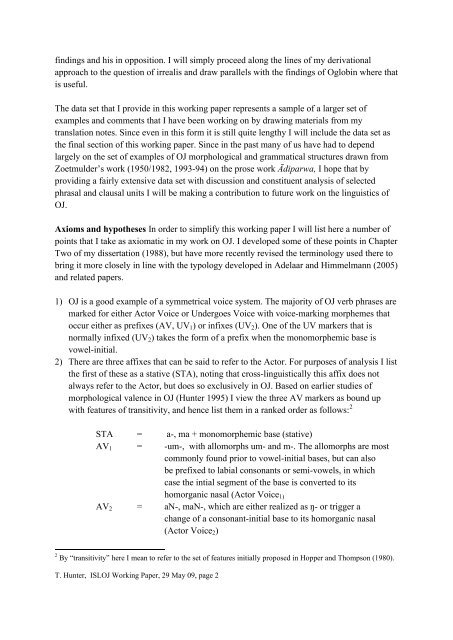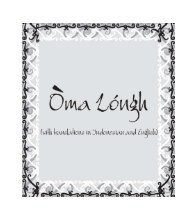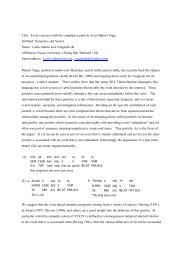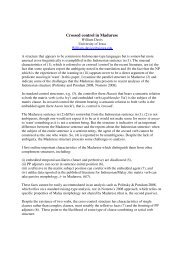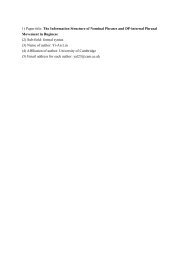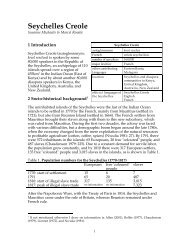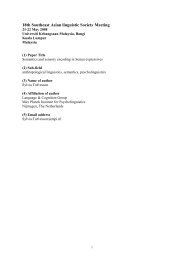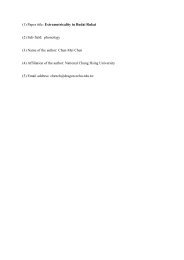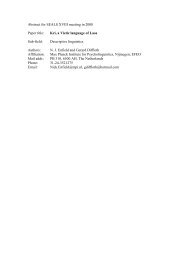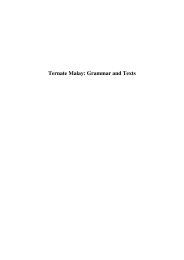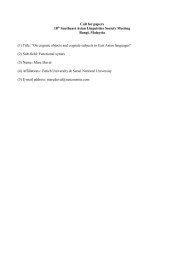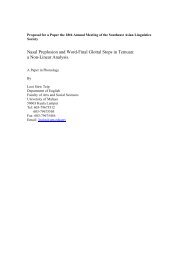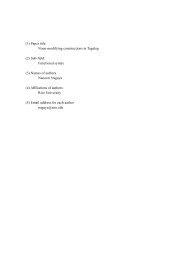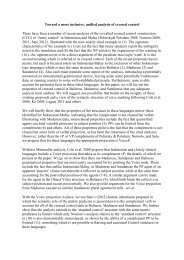Working Paper on Irrealis, Imperative Mode and Complementation ...
Working Paper on Irrealis, Imperative Mode and Complementation ...
Working Paper on Irrealis, Imperative Mode and Complementation ...
You also want an ePaper? Increase the reach of your titles
YUMPU automatically turns print PDFs into web optimized ePapers that Google loves.
findings <strong>and</strong> his in oppositi<strong>on</strong>. I will simply proceed al<strong>on</strong>g the lines of my derivati<strong>on</strong>al<br />
approach to the questi<strong>on</strong> of irrealis <strong>and</strong> draw parallels with the findings of Oglobin where that<br />
is useful.<br />
The data set that I provide in this working paper represents a sample of a larger set of<br />
examples <strong>and</strong> comments that I have been working <strong>on</strong> by drawing materials from my<br />
translati<strong>on</strong> notes. Since even in this form it is still quite lengthy I will include the data set as<br />
the final secti<strong>on</strong> of this working paper. Since in the past many of us have had to depend<br />
largely <strong>on</strong> the set of examples of OJ morphological <strong>and</strong> grammatical structures drawn from<br />
Zoetmulder’s work (1950/1982, 1993-94) <strong>on</strong> the prose work Ādiparwa, I hope that by<br />
providing a fairly extensive data set with discussi<strong>on</strong> <strong>and</strong> c<strong>on</strong>stituent analysis of selected<br />
phrasal <strong>and</strong> clausal units I will be making a c<strong>on</strong>tributi<strong>on</strong> to future work <strong>on</strong> the linguistics of<br />
OJ.<br />
Axioms <strong>and</strong> hypotheses In order to simplify this working paper I will list here a number of<br />
points that I take as axiomatic in my work <strong>on</strong> OJ. I developed some of these points in Chapter<br />
Two of my dissertati<strong>on</strong> (1988), but have more recently revised the terminology used there to<br />
bring it more closely in line with the typology developed in Adelaar <strong>and</strong> Himmelmann (2005)<br />
<strong>and</strong> related papers.<br />
1) OJ is a good example of a symmetrical voice system. The majority of OJ verb phrases are<br />
marked for either Actor Voice or Undergoes Voice with voice-marking morphemes that<br />
occur either as prefixes (AV, UV1) or infixes (UV2). One of the UV markers that is<br />
normally infixed (UV2) takes the form of a prefix when the m<strong>on</strong>omorphemic base is<br />
vowel-initial.<br />
2) There are three affixes that can be said to refer to the Actor. For purposes of analysis I list<br />
the first of these as a stative (STA), noting that cross-linguistically this affix does not<br />
always refer to the Actor, but does so exclusively in OJ. Based <strong>on</strong> earlier studies of<br />
morphological valence in OJ (Hunter 1995) I view the three AV markers as bound up<br />
with features of transitivity, <strong>and</strong> hence list them in a ranked order as follows: 2<br />
STA = a-, ma + m<strong>on</strong>omorphemic base (stative)<br />
AV1 = -um-, with allomorphs um- <strong>and</strong> m-. The allomorphs are most<br />
comm<strong>on</strong>ly found prior to vowel-initial bases, but can also<br />
be prefixed to labial c<strong>on</strong>s<strong>on</strong>ants or semi-vowels, in which<br />
case the intial segment of the base is c<strong>on</strong>verted to its<br />
homorganic nasal (Actor Voice1)<br />
AV2 = aN-, maN-, which are either realized as ŋ- or trigger a<br />
change of a c<strong>on</strong>s<strong>on</strong>ant-initial base to its homorganic nasal<br />
(Actor Voice2)<br />
2 By “transitivity” here I mean to refer to the set of features initially proposed in Hopper <strong>and</strong> Thomps<strong>on</strong> (1980).<br />
T. Hunter, ISLOJ <str<strong>on</strong>g>Working</str<strong>on</strong>g> <str<strong>on</strong>g>Paper</str<strong>on</strong>g>, 29 May 09, page 2


